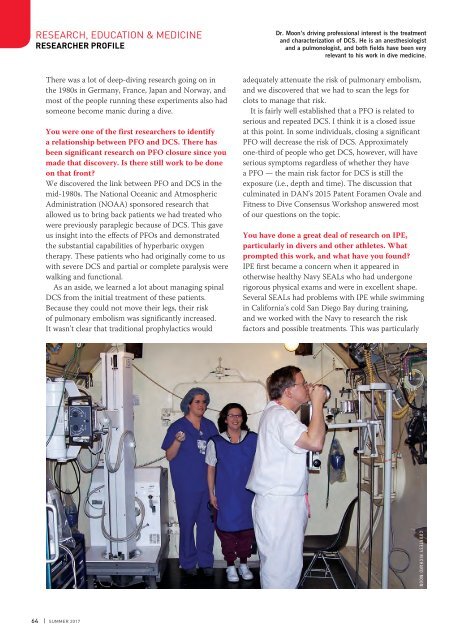AD 2017 Q3
Alert Diver is the dive industry’s leading publication. Featuring DAN’s core content of dive safety, research, education and medical information, each issue is a must-read reference, archived and shared by passionate scuba enthusiasts. In addition, Alert Diver showcases fascinating dive destinations and marine environmental topics through images from the world’s greatest underwater photographers and stories from the most experienced and eloquent dive journalists in the business.
Alert Diver is the dive industry’s leading publication. Featuring DAN’s core content of dive safety, research, education and medical information, each issue is a must-read reference, archived and shared by passionate scuba enthusiasts. In addition, Alert Diver showcases fascinating dive destinations and marine environmental topics through images from the world’s greatest underwater photographers and stories from the most experienced and eloquent dive journalists in the business.
You also want an ePaper? Increase the reach of your titles
YUMPU automatically turns print PDFs into web optimized ePapers that Google loves.
RESEARCH, EDUCATION & MEDICINE<br />
RESEARCHER PROFILE<br />
Dr. Moon’s driving professional interest is the treatment<br />
and characterization of DCS. He is an anesthesiologist<br />
and a pulmonologist, and both fields have been very<br />
relevant to his work in dive medicine.<br />
There was a lot of deep-diving research going on in<br />
the 1980s in Germany, France, Japan and Norway, and<br />
most of the people running these experiments also had<br />
someone become manic during a dive.<br />
You were one of the first researchers to identify<br />
a relationship between PFO and DCS. There has<br />
been significant research on PFO closure since you<br />
made that discovery. Is there still work to be done<br />
on that front?<br />
We discovered the link between PFO and DCS in the<br />
mid-1980s. The National Oceanic and Atmospheric<br />
Administration (NOAA) sponsored research that<br />
allowed us to bring back patients we had treated who<br />
were previously paraplegic because of DCS. This gave<br />
us insight into the effects of PFOs and demonstrated<br />
the substantial capabilities of hyperbaric oxygen<br />
therapy. These patients who had originally come to us<br />
with severe DCS and partial or complete paralysis were<br />
walking and functional.<br />
As an aside, we learned a lot about managing spinal<br />
DCS from the initial treatment of these patients.<br />
Because they could not move their legs, their risk<br />
of pulmonary embolism was significantly increased.<br />
It wasn’t clear that traditional prophylactics would<br />
adequately attenuate the risk of pulmonary embolism,<br />
and we discovered that we had to scan the legs for<br />
clots to manage that risk.<br />
It is fairly well established that a PFO is related to<br />
serious and repeated DCS. I think it is a closed issue<br />
at this point. In some individuals, closing a significant<br />
PFO will decrease the risk of DCS. Approximately<br />
one-third of people who get DCS, however, will have<br />
serious symptoms regardless of whether they have<br />
a PFO — the main risk factor for DCS is still the<br />
exposure (i.e., depth and time). The discussion that<br />
culminated in DAN’s 2015 Patent Foramen Ovale and<br />
Fitness to Dive Consensus Workshop answered most<br />
of our questions on the topic.<br />
You have done a great deal of research on IPE,<br />
particularly in divers and other athletes. What<br />
prompted this work, and what have you found?<br />
IPE first became a concern when it appeared in<br />
otherwise healthy Navy SEALs who had undergone<br />
rigorous physical exams and were in excellent shape.<br />
Several SEALs had problems with IPE while swimming<br />
in California’s cold San Diego Bay during training,<br />
and we worked with the Navy to research the risk<br />
factors and possible treatments. This was particularly<br />
COURTESY RICHARD MOON<br />
64 | SUMMER <strong>2017</strong>









